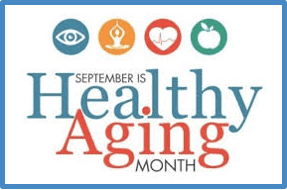Guest Post by Dr. Tyler Horton PT, DPT, MCS, MSCS
September is National Healthy Aging month and we will be spotlighting fall prevention. According to the US Preventative Services Task Force, falls are the leading cause of injury in adults ages 65 and older. 1 in 3 of community dwelling inpiduals in this age category experience a fall at least once and year and between 20-30 percent of these result in moderate to severe injuries. Fortunately, there are many steps that can be taken to help reduce the risk of falls both at home and in the community. In this article, we will review the extrinsic and intrinsic factors associated with falls and what can be done to manage these.
Extrinsic Factors
Extrinsic factors are associated with the environment that we live in. This includes first and foremost the home setting. More than 60 percent of falls occur at home and there are many steps that can be taken to reduce the risk of occurrence. The following are ways that you can make your home safer to reduce risk of falls.
– Proper lighting
– Minimize use of throw rugs
– Clear electric cords and clutter
– Remove wheels on chairs
– Add a raised toilet seat and grab bars
– Put non-skid treads on steps
Intrinsic Factors
 Intrinsic or internal factors are those that are related to the particular person including poor balance, medication side effects or impaired vision. It is common to see balance decline as we age for a number of reasons. A component of balance includes strength. The strength in our leg muscles declines due to a process known as age related sarcopenia. Researchers believe this is due to a reduction in nerves that connect the brain to muscle tissue as well as a reduced ability to use protein for energy.
Intrinsic or internal factors are those that are related to the particular person including poor balance, medication side effects or impaired vision. It is common to see balance decline as we age for a number of reasons. A component of balance includes strength. The strength in our leg muscles declines due to a process known as age related sarcopenia. Researchers believe this is due to a reduction in nerves that connect the brain to muscle tissue as well as a reduced ability to use protein for energy.
Another reason balance can decline as we age is due to sensory changes. Our nervous system is responsible for the sensation of touch and vibration as well as position sense. As we age, there is a decrease in blood flow to the nerve endings, which results in an impaired ability for the nerve axons to send signals back to the brain. This can place an older inpidual at an increased risk of falls because we rely on all the feedback we get from our nervous system to move effectively.
Ultimately at Alliance Orthopedics we can help to improve patient’s balance in a multi-system approach. Through a thorough examination by one of our physical therapists, specific balance systems can be identified as impaired. An inpidualized treatment plan will be developed to improve dynamic stability and reduce the risk of falls for our patients.

